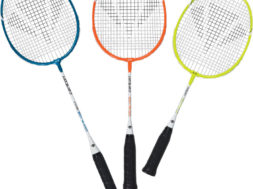When it comes to racket sports, badminton and tennis and even squash share a very similar appearance with regard to the rackets used. Badminton rackets have been constructed primarily from wood throughout their history and into the 1960’s.
These rackets tended to be oval shaped and used gut type strings. The handles that were used were designed with comfort in mind, rather than performance, grip, or style. In the 1960’s, however, metal racket frames began to become popular. These rackets also started to combine wood and metal, which allowed the top players in the world to gain more control of the shuttlecock and points during matches.
Wood by itself had suddenly proven to be limiting, not only in the shape but also in the tension that could be added to the strings. Tension allows a player to have more or less control and also to determine the power of the shots played depending on the tightness of the tension.
In the latter part of the 1960’s, aluminum frames were becoming more popular. This allowed a variety of manufacturers and well known brand names to produce different racket styles more inexpensively. As a result, players were afforded more choices and were then able to find the right racket that would have the best feel for them. It was no longer a one-size-fits-all approach.
During the 1970’s and throughout the 1980’s, carbon composite badminton rackets hit the market and these were lighter than ever. These rackets tended to be less durable than their aluminum counterparts, but allowed manufacturers the opportunity to experiment with different composites, such as part aluminum/part carbon fiber, which ultimately paved the way for graphite in the 1990’s.
When titanium was added to graphite composite rackets during the 1990’s, manufacturers had found a great blend of the lightest materials with the best durability. Players were able to increase power and control as well as add speed to their game. The stronger composites also allow for tighter string tensions, though not quite as tight as aluminum would allow. With just the right combination of composites and strength, any player could find the ideal tension that suited his or her game perfectly. These advances have allowed the major sports racket manufacturers to produce a wide range of badminton rackets to suit all levels of player ranging from the beginner to the professional tournament competitors.
It’s interesting to see how similar the progression has been with regard to badminton rackets and tennis and squash rackets. Innovations within one sport have carried over to these other racket sports allowing many top brands and well known names to produce high quality rackets for tennis, squash and badminton.





